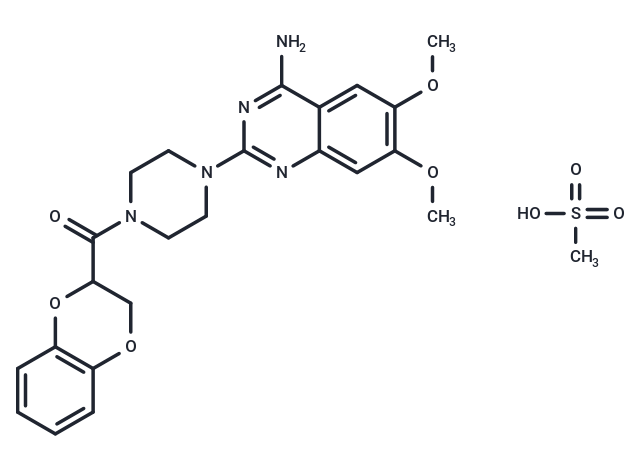Shopping Cart
- Remove All
 Your shopping cart is currently empty
Your shopping cart is currently empty

Doxazosin mesylate (UK 33274 mesylate)(UK 33274) is a quinazoline-derivative. It is a selectively antagonizes postsynaptic α1-adrenergic receptors.

| Pack Size | Price | Availability | Quantity |
|---|---|---|---|
| 200 mg | $38 | In Stock | |
| 500 mg | $64 | In Stock | |
| 1 g | $82 | In Stock | |
| 1 mL x 10 mM (in DMSO) | $50 | In Stock |
| Description | Doxazosin mesylate (UK 33274 mesylate)(UK 33274) is a quinazoline-derivative. It is a selectively antagonizes postsynaptic α1-adrenergic receptors. |
| In vitro | Doxazosin reduces mean arterial pressure by 18% without affecting the heart rate in all hamsters. It also significantly decreases the wet weight of mouse prostate reconstitution (MPR) in Beta TGF-β1-infected mice. |
| In vivo | Doxazosin, similar to chenodeoxycholic acid, decreases plasma total cholesterol, LDL plus VLDL cholesterol, and mean total triglycerides by 46%, 61%, and 45%, respectively. It diminishes the viability of neonatal rat cardiomyocytes in primary culture, with Hoechst staining in vivo indicating apoptosis in human-derived cardiomyocytes induced by Doxazosin. It prompts DNA damage and cell death in the HL-1 cell line. The apoptosis induced by Doxazosin can be blocked by a specific caspase-8 inhibitor, suggesting caspase-8’s functional involvement in the cell apoptosis triggered by Doxazosin. Moreover, Doxazosin antagonizes the VEGF-mediated angiogenic response in HUVEC cells by obliterating cell adhesion to fibronectin and collagen surfaces, and by inhibiting cell migration through downregulation of Vascular Endothelial Growth Factor expression. Doxazosin also increases FADD recruitment and caspase-8 activation, implying Fas-mediated apoptosis as a fundamental mechanism of Doxazosin's action in prostate cells. |
| Kinase Assay | Protease assays: To determine the inhibition constants (Ki) for each Prt inhibitor, purified HIV-1 RF wild-type Prt (2.5 nM) is incubated at 37 ℃ with 1 μM to 15 μM fluorogenic substrate in reaction buffer (1 M NaCl, 1 mM EDTA, 0.1 M sodium acetate [pH 5.5], 0.1% polyethylene glycol 8000) in the presence or absence of Atazanavir. Cleavage of the substrate is quantified by measuring an increase in fluorescent emission at 490 nM after excitation at 340 nM using a Cytofluor 4000. Reactions are carried out using 1.36 μM, 1.66 μM, 2.1 μM, 3.0 μM, 5.0 μM, or 15 μM substrate in the presence of five concentrations of Atazanavir (1.25 nM to 25 nM). Substrate cleavage is monitored at 5-min intervals for 30 min. Cleavage rates are then determined for each sample at early time points in the reaction, and Ki values are determined from the slopes of the resulting Michaelis-Menten plots. |
| Alias | UK 33274 mesylate |
| Molecular Weight | 547.58 |
| Formula | C24H29N5O8S |
| Cas No. | 77883-43-3 |
| Smiles | C(=O)(C1Oc2c(OC1)cccc2)N1CCN(CC1)c1nc2c(c(n1)N)cc(c(c2)OC)OC.CS(=O)(=O)O |
| Relative Density. | no data available |
| Storage | Powder: -20°C for 3 years | In solvent: -80°C for 1 year | Shipping with blue ice. | ||||||||||||||||||||||||||||||
| Solubility Information | DMSO: 50 mg/mL (91.31 mM), Sonication is recommended. | ||||||||||||||||||||||||||||||
Solution Preparation Table | |||||||||||||||||||||||||||||||
DMSO
| |||||||||||||||||||||||||||||||

Copyright © 2015-2025 TargetMol Chemicals Inc. All Rights Reserved.